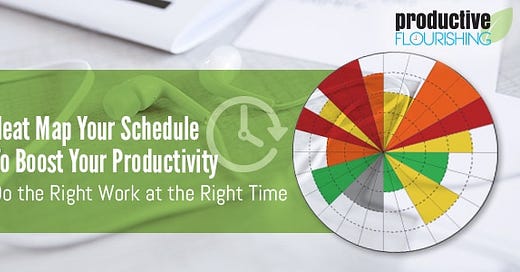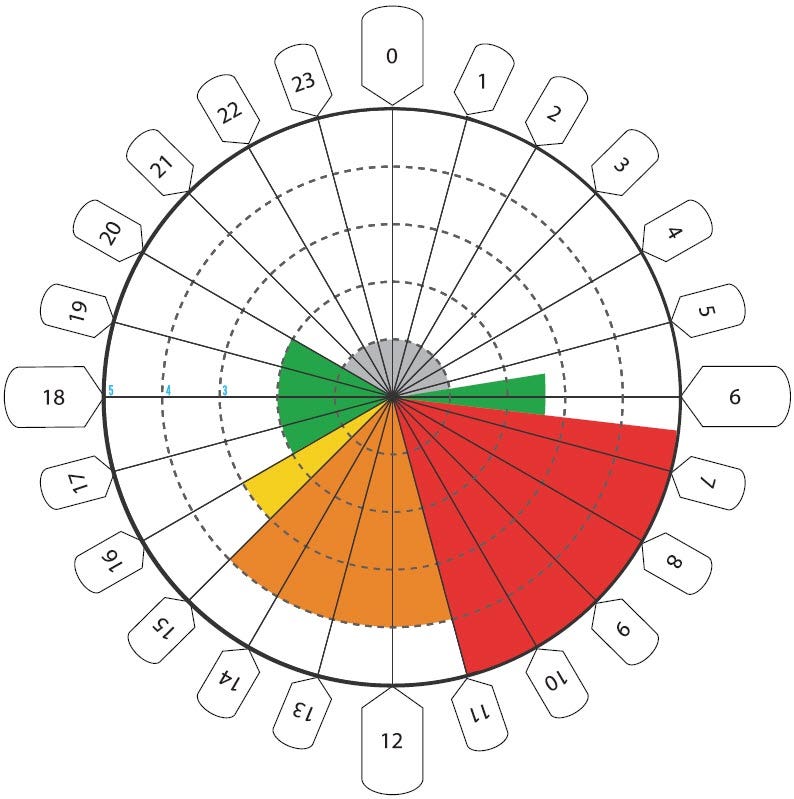How Heat Mapping Your Day Can Make You More Productive
The hours of your day aren't equal, energy-wise.
Productive capacity is different from what you’re actually producing. The way I think about it is that it’s the amount of productivity that you’re capable of in a given amount of time. Of course, many different things affect your ability to be productive, so there’s frequently a bit of difference between productive capacity and productivity.
But if you dig a little deeper, you’ll often see that there’s a surprising regularity in your bio-rhythms. As I was working with people on their creative rhythms, I needed a tool to visualize and track these energy states. The Productivity Heat Map was born.
Below is my heat map:
[You can grab a blank Daily Productivity Heat Map at the bottom of the post.]
I'll provide a quick legend for deciphering colors, in case you're not familiar with heat maps:
Red: This is where productive capacity is the highest. All systems are operational and ready for the captain to give the signal to go to warp speed. This is where I get all of my creative heavy-lifting done. I call this level the "nova" stage (from "supernova") because it's really hot and intense, and it's also something quick to say to my wife so that she knows what's going on with me (I get really, really frustrated by dealing with non-urgent issues during novas, since I am acutely aware of what else I could be doing).
Orange: This level of productive capacity is the waystation between creative awesomeness and merely puttering along. A lot of work can get done here, but you'll only be somewhat aware that you're working.
Yellow: This level of capacity is the idle status. Some productive work can be done, but it's not going to be the high-level, lose-track-of-time type of productivity.
Green: At this level, I'm spending more energy trying to keep working than actually doing the work itself. Creativity, motivation, or focus is pretty much gone.
Gray: Hopefully I'm asleep at this level. Unfortunately, all too often I'm still trying to get something done or can't sleep because some idea is teasing me.
So, you may be wondering why I decided to present this on a modified clock face rather than the standard columnar way that we normally present time. First, the "heat" of heat maps is normally mapped over something the way it actually appears. For instance, website heat maps display the relevant information over the way the site is presented to the reader.
More importantly, though, I like to think about time in its natural, circular state since I get a better overview of the relatedness of yesterday's activities to my state today.
Lastly, it takes up less space to get the information across once you understand the paradigm.
A few other presentation notes: I use 24-hour time for convenience and so that there's no need for two clocks. I use only four colors (plus gray) because they capture all of the information I need and keep me from quibbling about whether something's red-orange, orange, or red. Gray is used instead of black because it's easier to see and black is too often associated with death or some really, really bad state.
Why Breaking Your Day Into Energy Cycles is Useful
There's a good deal of usefulness in thinking about your day in this way.
For me, it helps answer the following questions:
1. Why do I have more productive capacity at some times than others?
You'll notice on the heat map above that from 08–11 and 14–16, I go nova. Then towards meal times I start to downshift. One obvious reason for this is that I get hungry and my blood sugar drops. A second, less obvious, reason this happens is that I can sustain peak focus for only about three hours.
A lot of the same reasons explain why I'm not good for a whole lot after 1600 (4 pm). If it's been a good, productive day, I've burned myself out by that point.
2. How can I move from one level to the next?
The heat map above is my (more or less) natural rhythm. With a little caffeine, food, and space, it's what my day will generally look like. But I've often wondered what I can do to move myself from a lower level of productivity to the next higher one.
What I've noticed is that I usually can shift up only one level. For instance, I can't get myself to go from yellow to red, although I can easily go from red to yellow. Apparently productive capacity is like heat: it goes from hot to cold pretty easily, but it takes a lot more effort to go from cold to hot. But moving from yellow to orange is a pretty good increase in productivity, so even making that change is worthwhile.
Here's an example from my productivity heat map. The block from 11 am to 2 pm is the most malleable block of time, but it's often the second most important part of the day (after the morning) because what happens during that block determines how the rest of my day will go. I have a few relatively simple methods for shifting that block up:
Eat a healthy, balanced breakfast; usually oatmeal with raisins, yogurt, a banana, some protein (generally eggs), juice, and 8-16 oz of water.
Drink roughly 8 oz of water an hour.
Coordinate with my wife so that she knows I'll not be up for going out for lunch and will probably just grab something quick.
Turn the phone on silent, leave the phone in another room, and don't check email.
Eat that quick lunch - take no more than 30 minutes for prep, eating, and cleanup. Stretch or walk for 5-10 minutes.
Get back to work. Do not check email or your phone messages during lunch.
Continue to drink 8 oz of water an hour.
I told you it was relatively simple, didn't I?
It works because it preempts all of the things that make me naturally downshift.
The good breakfast keeps energy levels high. The water does two things. First, it makes you think better. Second, it makes sure you take a break every hour or so, so you stretch, rest your eyes, and have a mini-break at regular intervals.
The coordination with Angela (my wife) lets her know that I'm going nova and removes those wasted 30–45 minutes when we're both trying to figure out what the other is doing for lunch. The quick lunch ensures that you don't disengage from what you're doing.
Not checking email and phone messages removes a lot of distractions and opens up a lot of psychic RAM. Having the phone in the other room removes it from my view and keeps me from even thinking about it.
I'll warn you that if you do this, you may not be good for a whole lot of work afterward, unless you've got much more mental fortitude than I do. Just make sure you do the right things during that block so that you'll feel rewarded for what you've done.
The plus side, though, is that I often do an entire week's worth of work in those six hours, so I can spend the rest of the time, all things being equal, on other pursuits. Like writing absurdly long blog posts.
3. How should I plan my day?
Knowing your rhythm allows you to plan the right tasks for the right times. I think a lot of personal planners miss this, and people look at all chunks of time as being equal.
All chunks of time are not equal! (Tweet this.)
I can get more done from 0800-1000 on most days than I can from 1600-2000, even though the latter block has twice as much time. As you can probably figure out, I try to put my writing in the morning blocks since I know that I can go nova during those periods. I may do some editing, planning, or networking during the orange blocks, and I try to check email and other low-horsepower stuff from 1600--1700.
Leveraging my day like that ensures I'm not up at 0200 in the morning trying to work and creating a product that I'll spend more time editing the next morning.
It does that in two very powerful ways: 1) I'm normally very satisfied with what I completed that day, as I know I couldn't have done any more than I did, and 2) I'm exhausted by 2200 (10 pm) or so, and if I'm thinking clearly, I know I'm going into a phase in which the time would be better spent sleeping.
4. Why do I get so pissed when I wake up late?
If I wake up past 0930, I'm grumpy for a long, long time because I know that the best, productive block of time is gone. I'll be at half-capacity, and I've got way too much that I'd like to do for that. So I'll try to work late that day, go to bed at 0445 (I'm not kidding), wake up late (1000ish) the next day, get pissed, go to bed at 0330, wake up late the next day (1100ish), and not be good for anything because I haven't been sleeping, eating, and drinking like I should.
Luckily, I'll generally be so exhausted by the third day that I sleep well and can start the right rhythm over again. But doing that loses me four nova blocks during that three-day period and those blocks are far too valuable to squander that way.
What’s Your Daily Heatmap Look Like?
Heat-mapping your productivity is a great way to get a grip on figuring out how to be more productive and how to plan your days, and it may take a few days of recording for you to find your natural rhythm. Get out your highlighters and markers!
And as we learned from G.I. Joe, knowing is half the battle!
You can download the Daily Productivity Heat Map below.
You can also find this and many of our other useful worksheets on our Free Planners page.







How did you determine which hours were most productive vs. Less productive? Was this based on any sort of data analysis?